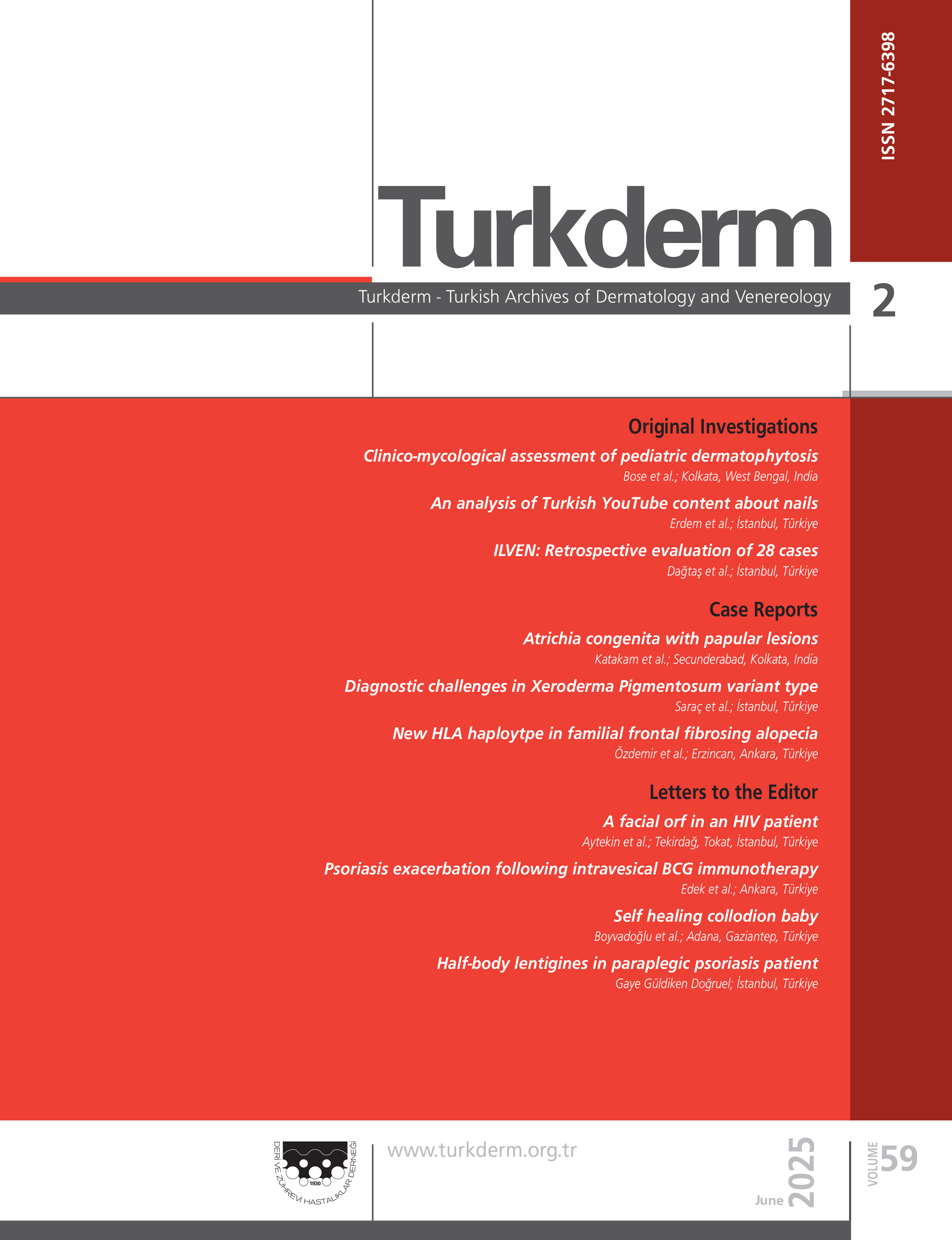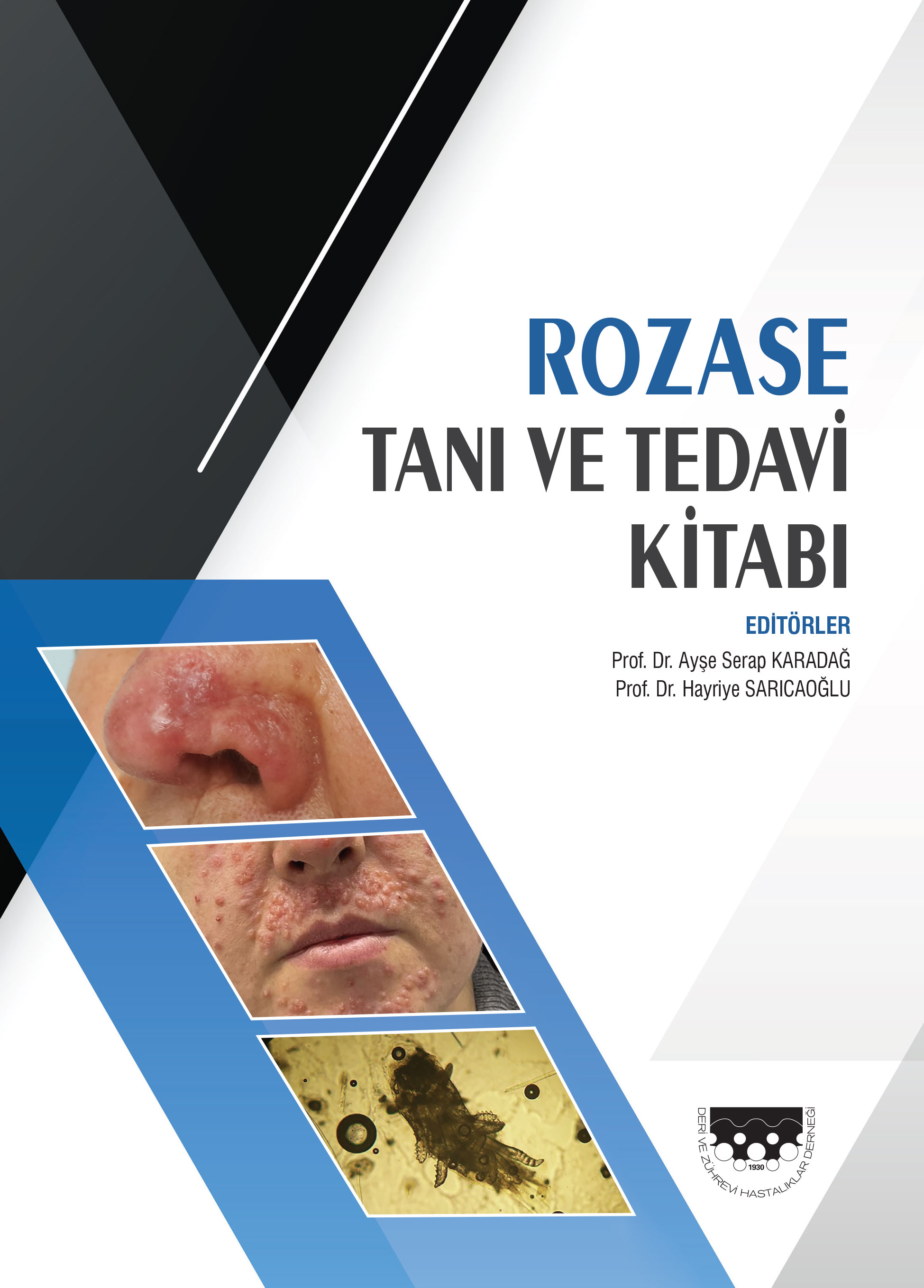Volume: 43 Issue: 4 - 2009
| EDITORIAL | |
| 1. | Importance and Necessity of Study Groups Page 1 Abstract | |
| REVIEW ARTICLE | |
| 2. | Ticks and Dermatology Emine Derviş Pages 132 - 138 In 2002, cases with Crimean-Congo Haemorrhagic Fever (CCHF ) were diagnosed in Turkey and increasing numbers of those similar cases in following years have caused a big concern around the whole country. Because of the increasing numbers of patients referred to the dermatology clinics with tick related skin conditions or just with the need for a tick extraction, we found it necessary to review the recent information about ticks and tick-related skin diseases. |
| ORIGINAL INVESTIGATION | |
| 3. | Fifty-six Cases with Mediterranean Spotted Fever: Evaluation of Tick-Borne Spotted Diseases in Turkey Gönül Şengöz, Filiz Yıldırım, Kadriye Kart Yaşar, Ümit Tözalgan, Özlem Altuntaş Aydın Pages 139 - 143 Background and Design: There are very few clinical series about Mediterranean Spotted Fever (MSF) reported from Turkey. Fifty-six patients admitted with fever and rash were diagnosed as MSF in our hospital by clinical, epidemiological signs and Weil-Felix test. We aimed to take attention to the similarities and differencies with another tick-borne infection Crimean-Congo Haemorrhagic Fever (CCHF) reported lately in Turkey. Material and Method: Between 1989-2006 years 56 cases were diagnosed as rickettsioses based on epidemiological, clinical and laboratory data. We evaluated the patients retrospectively using by Diagnosis guide for tick transmitted infections in Europe prepared by ESCMID Study group for Coxiella, Anaplasma, Rickettsia and Barthonella (ESCAR). We compared two diseases according to the Fishers exact test in clinical and laboratory characteristics. Results: Twenty-nine female and 27 male cases reached to 25 point according to ESCAR diagnostic scoring were included into the present study. Age distribution was 20-80 years (mean 43), duration of hospitalization was 1-38 days (mean 8 days). Tache noire was established in most of the cases (64%). All of the cases were recovered by 7-10 days of doxycyclin treatment except one case stayed in hospital for 38 days and died. When it is compared statistically haemorrhagic manifestations, history of tick exposure, nausea and vomiting, thrombocytopenia and leukopenia rates were found higher in CCHF (p<0.05). Conclusion: Whereas MSF and CCHF have similar seasonal and clinical features and transmitted by the tick, the treatment regimen and mortality rates differ. In Istanbul we realised that some of the cases reported as possible CCHF were found to be MSF later, for this reason in patients who has fever and maculopapular rash with a history of tick exposure, MSF should always be kept in mind. The differential diagnosis of CCHF and MSF which can cause epidemics in our country should be done by newly developed molecular tests and diagnosis guides. |
| 4. | Evaluation of dermatologic emergeny patients: An unicentral prospective clinical study Hilal Kaya Erdoğan, İlknur Kıvanç Altunay, Adem Köşlü Pages 144 - 148 Background and Design: The definition of emergent diseases includes potentially risky diseases that need urgent medical intervention. Diagnostic and therapeutic processes are managed mostly at ourpatient setting in dermatology. Therefore, it is unclear that which diseases are real emergencies and which patients apply urgently. There are a few studies assessing this topic. Our aim was to evaluate patients referred to our clinic urgently, and to review the concept of real dermatologic emergency by comparing dermatologic emergency patients and outpatients. Material and Method: A total of 800 patients (400 urgent patients, 400 outpatients) were included. Demographic features, complaints, disease duration and severity, whether the disease occurs for the first time were questionned, application time and diagnosis were recorded. The opinions of patients and physicians were inquired about why they thought that the disease was emergent. Results: Most common skin diseases were acute urticaria-angioedema, contact dermatitis, and insect bite in emergency patients; acne vulgaris, verruca and tinea pedis in outpatients. Itching was more common in emergency patients. Emergency patients' complaints were more severe than those of outpatients. Patients who experience disease first time applied to emergency service more than others. Emergency patients had a shorter disease duration than outpatients. Patients and physicians revealed different reasons and criteria about the urgency of the diseases. 93.5% of patients and 49% of physicians thought that existing disease was emergent. Conclusion: Our data reveal that the concept of dermatologic emergency is unsettled. It changes according to socio-cultural, personal features and to the present health system. Determination of the main criteria of the definition of dermatologic urgent, and training of dermatologists, emergency centersphysicians and also of patients in this regard seem to be a necessity to decrease pseudo-emergencies. |
| 5. | Melanocytic Nevi Prevalence and the Relationship with Sun Exposure Among School Children Meltem Uslu, Ekin Şavk, Göksun Karaman, Neslihan Şendur Pages 149 - 154 Background and Design: Melanocytic nevi (MN) count is known as the strongest risk factor for melanoma development. So it is important to know the MN count in public. We aimed to determine the MN prevalence in schoolchildren and also clarify the possible relation between MN counts, constitutional variables and sun exposure. Material and Method: In this randomized, cross-sectional study, a questionnaire asking skin phenotypes and sun exposure in previous summer was prepared for primary-school children. Nine hundred and sixty questionnaires distributed to the parents. Children who were given permission by parents for examination were examined for whole body MN. Results: Questionnaires were answered by parents of 939 children and 622 children (316 boys and 306 girls) were examined. Mean age of children was 8.8±1.5 (6-12). Mean MN count was 19.6±16.6 and this count was increasing with age (p<0.001). MN count was significantly related with sex, skin phototype and skin colour. More MN were found in boys (p<0.001), children with sun sensitive phototypes (p=0.03) and light skin colour (p<0.001). Time spent outside on midday in previous summer was not related with the MN count (p=0.35). Sunburns experienced in previous summer were not related with MN count (p=0.11). MN were most densely located on the face, and then on upper extremity, trunk and lower extremity in decreasing order. There were more MN on the more sun exposed sites of the arms, hands and feet. Conclusion: It was found that previous summer sun exposure had no effect on MN count in schoolchildren. However, relation between MN count and skin phenotype and distribution of the MN on the body suggest that sun exposure could affect MN count and this effect could be seen in a long period of time. |
| 6. | Evaluation of Sun Protection Habits and Melanocytic Nevi of Population Screened in a Shopping Mall in Ankara Nilsel İlter, Murat Orhan Öztaş, Esra Adışen, Mehmet Ali Gürer, Özge Keseroğlu, Selda Ünal, Bilge Kıraç, Jale Yüksek, Canan Kevlekçi, Deniz Çetinkünar, Banu Öztürk, Nergis Eroğlu Pages 155 - 159 Background and Design: The evaluation of sun protection habits, numbers and types of nevi in our community. Material and Method: A stand was built in a big mall in Ankara where 764 patients were screened for the presence of nevi in three working day periods during the month of May of 2005 and 2006. Lesions were evaluated with the help of digital dermatoscopy. In the study, sun protective practices, sunscreen using habits, dermatoscopic diagnosis of the lesions, numbers and the localization of the lesions were also recorded. Results: The study population consisted of 764 patients (438 female, 326 male) with age ranging from 1 to 80 (33.7±13.7) years. 55.6% of them had skin type III, 47.3% had sunburn history. Most of the patients (44.1%) were not using sunscreens. Hats and umbrellas (40.3%) were the most common accessories used for protection. 904 lesions of 764 patients examined by dermatoscopy revealed that the most common diagnosis was nevi. Two patients were diagnosed with having cutaneous melanoma or basal cell carcinoma. Conclusion: Our findings have shown that the general population is not aware of the risks of sun exposure or the appropriate ways for sun protection and that there is a necessity for educational programmes or campaigns about sun protection and nevi in our general population. |
| 7. | The Recurrence and Cosmetic Results After Topical Photodynamic Therapy Can Ceylan, Fezal Özdemir, Alican Kazandı Pages 160 - 166 Background and Design: Photodynamic therapy (FDT) is a photochemotherapy modality which is used frequently and effectively in the treatment of actinic keratosis, Bowen disease and basal cell carcinomas. This study was performed to determine cure rates, cosmetic outcome and recurrence rates after aminolevulinic acid (ALA)-based photodynamic therapy for skin lesions showing complete response to treatment procedure. Material and Method: Sixty-eight patients (27 females and 41 males) with 78 lesions were included in the study. Among them, 25 were actinic keratosis (AK), 8 were actinic cheilitis (AC), 30 were basal cell carcinomas (BCC), 3 were Bowen disease, 10 were intraepidermal epithelioma (IEE), one lesion was parapsoriasis and one lesion was verruca plantaris. Six to 8 hours after topical administration of ALA (20%), the lesions were exposed to light from a broad-band light source. Skin biopsy specimens were obtained from 74 lesions for histopathological control. Results: At the end of the second month of treatment, fifty-six (72%) of seventy-eight lesions showed complete clinical response, whereas fourty-seven of 74 lesions (63.5%) exhibited complete histopathological clearance. A total of 9 recurrences (16%) was observed during a median follow-up of 36 months. Recurrence rates were 3 (14%) in AK, 1 (17%) in AC, 1 (8%) in superficial BCC, 3 (75%) nodular BCC and 1 (12.5%) in IEE. Cosmetic outcome was excellent and good in 42 lesions (89%), fair in 3 lesions (6%) and poor in 2 lesions (5%). Conclusion: Topical photodynamic therapy is a noninvasive, effective and cosmetic modality of treatment in the selected skin lesions, as an alternative to the conventional procedures. |
| 8. | Keratinocyte Apoptosis is Decreased in Psoriatic Epidermis Semih Tatlıcan, Ata Türker Arıkök, Özlem Gülbahar, Cemile Eren, Zeliha Ulukaradağ, Fatma Eskioğlu Pages 167 - 170 Background and Design: Abnormal differentiation and hyperproliferation of keratinocytes are the hallmarks of psoriasis vulgaris. Although psoriasis vulgaris is generally accepted as a disease of decreased keratinocyte apoptosis, the results are contradictory. The aim of the current study is to investigate whether decreased keratinocyte apoptosis contributes to the formation of a thickened epidermis as increased keratinocyte proliferation. Material and Method: Forty-three untreated psoriasis vulgaris patients and 20 healthy control subjects were included into the study. Biopsy specimens taken from the enrollee were evaluated by immunohistochemical staining for Ki-67 expressions to show the proliferation of keratinocytes and by the terminal deoxynucleotidyl transferase-mediated dUTP-biotin nick-end labeling (TUNEL) method to show the apoptotic keratinocytes. Results: Apoptotic index (percentage of the TUNEL positive cells) was significantly lower in psoriatic epidermis (0.33±0.64) than in normal epidermis (0.75±0.85); whereas Ki-67 index (percentage of positively staining cells for Ki-67) was significantly higher in psoriatic epidermis (30.86±10.49) than in normal epidermis (11.65±2.98), (p=0.021 and p=0.00; respectively). Conclusion: Decreased keratinocyte apoptosis also contribute to increased epidermal thickness in psoriasis as well as increased keratinocyte proliferation. |
| TURKDERM-9860 | |
| 9. | Kimura Diseases: A Case Report Hakan Cinemre, Feyzi Gökosmanoğlu, Cemil Bilir Pages 171 - 173 Kimura is a chronic inflamatuary disease at oral mucosa which presents as large subcutaneous nodules or masses on the head or neck of adulthood males. The lesions characteristics are eosinophilia in lymphocytic infiltration, fibrosis and diffuse vascularity. Eosinophilia and elevated blood IgE can be peresent. A 62 years old female with inguinal mass and itching was presented. |
| 10. | A Case of Eosinophilic Ulcer Localized at Lower Lip Hicran Yetkin, Pınar Yüksel Başak, Vahide Baysal Akkaya, Gülsün İnan, Nilgün Kapucuoğlu Pages 174 - 176 Eosinophilic ulcer of the oral mucosa is an uncommon, benign and self-limiting disease. Although exact pathogenesis of the disease is unknown, trauma is thought to play a role in the etiology. Eosinophilic ulcer is characterised by an ulcer with an indurated border, commonly occurring on the tongue but also on any region of the lips and oral mucosa. The ulcerated lesion with acute onset may heal spontaneously within 1 week to 8 months. A 23 year-old-man man was admitted for painful ulceration on the lower lip for seven years which flares up during summers and heals spontaneously. Clinical and histopathological findings of the case, consistent with eosinophilic ulcer, is presented because of its rare occurrence as well as clinical resemblance to squamous cell carcinoma of the lower lip. |
| 11. | Herpes Zoster in a Healthy Child Ahu Çiler Çıkım Pages 177 - 179 Varicella zoster virus (VZV) is the causing agent of chickenpox which is common in children. Herpes zoster (HZ) is a latent infection that is caused by VZV, which is localized in the cells of dorsal root ganglions. HZ is rare in childhood and is especially encountered in immunosuppressed children. Here, an immunocompetent child with HZ is presented and the clinical symptoms, treatment and complications of the infection are reviewed. |
| 12. | A Case of Vohwinkels Syndrome Succesfully Treated with Acitretin Ali Murat Ceyhan, Mehmet Yıldırım, Vahide Baysal Akkaya, Nilüfer Şahin Calapoğlu Pages 180 - 182 Vohwinkel's syndrome (Keratoderma hereditaria mutilans) is a rare genodermatosis consisting of hyperkeratosis of the palms and soles with a characteristic "honeycomb" appearance, "starfish-shaped" keratotic plaques on the dorsum of hands and feet and fibrous constricting bands (pseudoainhum) at the interphalangeal joints. Associated findings with the disease are cicatricial alopecia, ichthyosiform dermatoses, acoustic impairment, deafness, spastic paraplegia and myopathy, and nail anomalies. Etretinate and isotretinoin have been used successfully in several patients with Vohwinkel's syndrome to reverse both the keratoderma and pseudoainhum. In this report, we described a case with Vohwinkel's syndrome that presented with generalized ichthyosis, diffuse palmoplantar keratoderma, pseudoainhum, onychogryphosis, ectropion and bilateral sensorineural hearing loss and was successfully treated with acitretin, 35 mg/day orally. (Turkderm 2009; 43: 180-2) In this report, we described a case with Vohwinkel's syndrome that presented with generalized ichthyosis, diffuse palmoplantar keratoderma, pseudoainhum, onychogryphosis, ectropion and bilateral sensorineural hearing loss and was successfully treated with acitretin, 35 mg/day orally. |
| WHAT IS YOUR DIAGNOSIS? | |
| 13. | What is Your Diagnosis? Filiz Cebeci Pages 183 - 184 Abstract | |
| TURKDERM-6637 | |
| 14. | News Page 185 Abstract | |
| NEW PUBLICATIONS | |
| 15. | New Publications Page 186 Abstract | |
| NONE | |
| 16. | 2009 Referee Index Page 187 Abstract | |
| 17. | 2009 Author Index Page 188 Abstract | |
| 18. | 2009 Subject Index Pages 189 - 190 Abstract | |
| 19. | Ulusal Kongre Takvimi Page 191 Abstract | |























